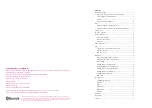
NTSC
The color television encoding system used in North America was originally
defined by the National Television Standards Committee. This American standard
has also been adopted by Canada, Mexico, Japan, Korea, and Taiwan. (This
standard is referred to disparagingly as Never Twice Same Color.)
Optical
An optical interface between two devices carries data by modulating a light
source. This light source is typically a laser or laser diode (similar to an LED)
which is turned on and off at the bitrate of the datastream. The light is carried
from one device to another through a glass fiber. The fiber’s core acts as a
waveguide or lightpipe to carry the light energy from one end to another. Optical
transmission has two very significant advantages over metallic copper cables.
Firstly, it does not require that the two endpoint devices have any electrical con-
nection to each other. This can be very advantageous in large facilities where
problems with ground loops appear. And secondly, and most importantly, an
optical interface can carry a signal for many kilometers or miles without any
degradation or loss in the recovered signal. Copper is barely useful at distances of
just 1000 feet.
Oversampling
A technique to perform digital sampling at a multiple of the required sample rate.
This has the advantage of raising the Nyquist Rate (the maximum frequency that
can be reproduced by a given sample rate) much higher than the desired
passband. This allows more easily realized anti-alias filters.
PAL
During the early days of color television in North America, European broadcast-
ers developed a competing system called Phase Alternation by Line. This slightly
more complex system is better able to withstand the differential gain and phase
errors that appear in amplifiers and transmission systems. Engineers at the BBC
claim that it stands for Perfection At Last.
Progressive
An imaging scanning technique that progresses through all of the lines of a frame
in a single pass. Computer monitors all use progressive displays. This contrasts to
the Interlace technique common to television systems.
Return Loss
An idealized input or output circuit will exactly match its desired impedance
(generally 75 ohms) as a purely resistive element, with no reactive (capacitive or
inductive) elements. In the real world, we can only approach the ideal. So, our
real inputs and outputs will have some capacitance and inductance. This will
create impedance matching errors, especially at higher frequencies. The Return
Loss of an input or output measures how much energy is returned (reflected back
due to the impedance mismatch.) For digital circuits, a return loss of 15 dB is
typical. This means that the energy returned is 15 dB less than the original
signal. In analog circuits, a 40 dB figure is expected.
BrightEye-15
TM
BrightEye 24



































